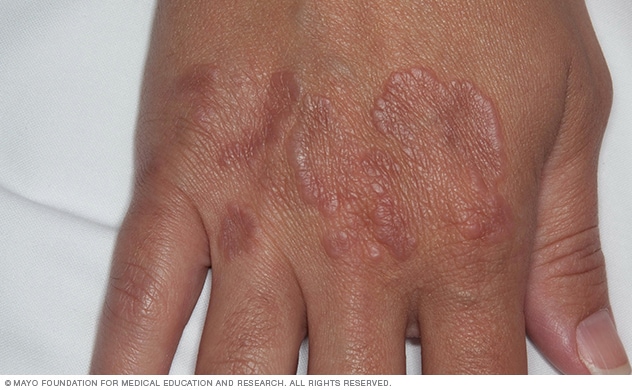Overview
-
Granuloma annulare
Granuloma annulare (gran-u-LOW-muh an-u-LAR-e) is a skin condition that most commonly consists of raised, reddish or skin-colored bumps (lesions) that form ring patterns — usually on your hands and feet.
No one knows exactly what causes granuloma annulare. But it may be triggered by minor skin injuries and certain medications. Some types of granuloma annulare affect adults, and others typically affect children.
In most cases, granuloma annulare isn't itchy or painful, so no treatment is necessary. The lesions usually disappear on their own within two years. If you're bothered by how your skin looks, your doctor can prescribe medications that will speed the disappearance of the lesions.
Symptoms
The signs and symptoms of granuloma annulare can vary, depending on the variety:
- Localized. This is the most common type of granuloma annulare. The bump (lesion) borders have a circular or semicircular shape, with a diameter up to 2 inches (5 centimeters). It occurs most commonly on the hands, feet, wrists and ankles of young adults.
- Generalized. Up to 15 percent of the people who have granuloma annulare have lesions over a large portion of their bodies — including the trunk, arms and legs. This type is more likely to be itchy and to affect adults.
- Under the skin. A type that usually affects young children is called subcutaneous granuloma annulare. It produces firm, usually painless, lumps under the skin instead of a rash. The lumps are usually less than 1.4 inches (3.5 centimeters) in diameter and appear on the hands, shins and scalp.
Causes
No one knows exactly what causes granuloma annulare. But in some people, the condition may be triggered by:
- Animal or insect bites
- Infections, including hepatitis
- Tuberculin skin tests
- Vaccinations
- Sun exposure
- Other minor injury to the skin
Granuloma annulare is not contagious.
Risk factors
Granuloma annulare is occasionally associated with diabetes or thyroid disease, most often when lesions are numerous or widespread.
Diagnosis
Your doctor may diagnose granuloma annulare by examining the affected skin. He or she may take a small skin sample (biopsy) to examine under a microscope.
Treatment
In most cases, no treatment is necessary for granuloma annulare. Most lesions disappear within a few months, and rarely last more than two years. If the appearance of your skin bothers you, your doctor may recommend:
- Corticosteroid creams or ointments. Prescription-strength products may help improve the appearance of the lesions and speed their disappearance. Your doctor may direct you to cover the cream with bandages or an adhesive patch, to increase the effectiveness of this treatment.
- Corticosteroid injections. If the skin lesions are thicker and your symptoms are greater, your doctor may inject corticosteroids directly into the lesions to help them disappear faster.
- Freezing the lesions. Applying liquid nitrogen to the affected area can help remove the lesions and stimulate the growth of new skin.
- Light therapy. Exposing the lesions to particular types of light is sometimes helpful. Certain types of laser treatments also work for some people.
- Oral medications. In severe cases, especially when the lesions are widespread, your doctor might prescribe antibiotics, antimalarials or drugs used to prevent immune system reactions.

No comments:
Post a Comment